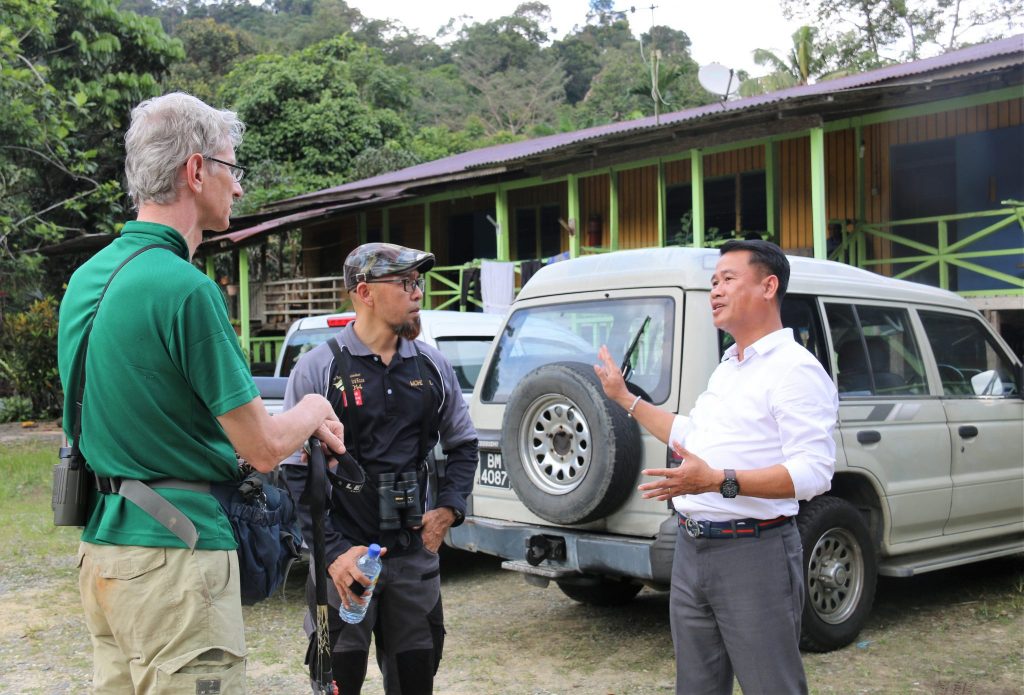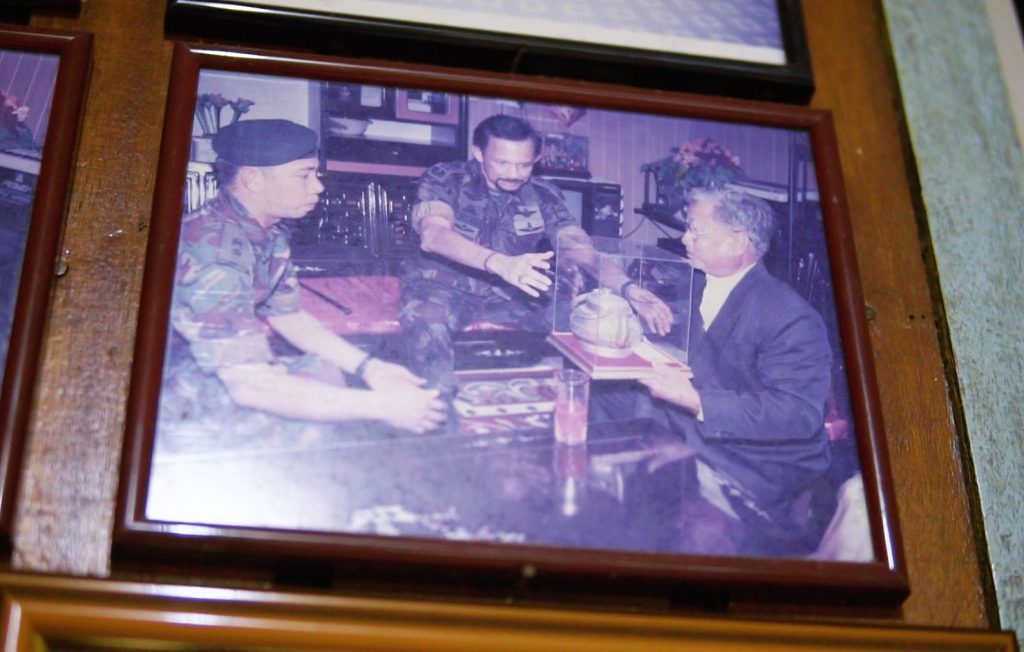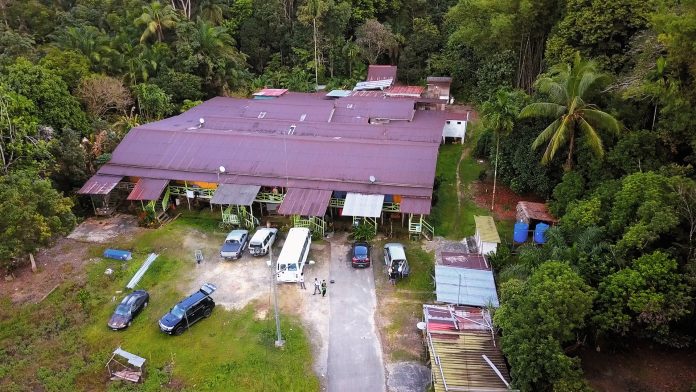It might be the heart of the Sultanate’s economy – but it’s no secret that Belait has struggled to lure international visitors outside the oil and gas industry.
Just 45km away from Miri’s bustling commercial centre, Belait – the nation’s biggest district by land mass – rarely escapes descriptions as a sleepy coastal town.
Aside from day trips to oil monuments in Seria, Belait is seen by tour agents to be too far from the capital to be marketed seriously, and in the field eco-tourism, the green jewel known as Temburong still reigns supreme.
But there’s an unlikely contender, located at the very end of the asphalt of Jalan Labi, deep in Belait’s rural south, that’s starting to gain ground.
A wooden longhouse, dwarfed by a surrounding enclave of lush tropical forest and some 40 waterfalls, is the sole settlement in Teraja – and in 2017, drew close to 4,000 visitors.
Built on stilts about the average man’s height, the Teraja longhouse appears sturdy but worn; stair posts and handles painted a mint-ish green, with a façade of yellow wooden panels and doors in blue.
Sitting with silent authority inside the ruai – a communal corridor that separates the longhouse entrance and its private living quarters – is Jamit Anak Lasah, the patriarch of the sole settlement in Teraja.
He is short, stocky and still has full head of silver hair. His skin, leathered by the sun, wears all of his 80 years, but his posture holds firm as we sit cross-legged on the linoleum floor for an interview.
“Our people built this house with our bare hands,” says Jamit proudly as he taps the floor. “There were no others that helped us build it.”
With accounts into the area’s biodiversity by researchers and a growing number of trekking guides written by adventure enthusiasts, Teraja may be on the cusp of entering the mainstream consciousness – but much remains to be learned about its history.
This is their story – told by the descendants of its original inhabitants.
From Marudi to Belait: In search of opportunity
Anecdotes of how Belait’s rural, innermost communities came to be are mostly tales of migration from modern-day Sarawak. A riverine settlement, that later formed into a town, southwest of Brunei’s border known as Marudi bears particular significance; the Iban residents of Teraja and Melilas claim their ancestors to have descended from there.
Jamit’s (pictured below) father Lasah first arrived in Belait’s south in the 1920s, traversing by foot from Marudi across trails in dense tropical forest in search of economic opportunity. “Back then he didn’t even know he had crossed into Brunei,” says Jamit. “A man would search for employment or an area that he could settle into and farm.
“You didn’t need to present papers if you were looking to be hired. If you presented yourself as able-bodied, ready and willing to work hard, the job would be yours.”
Arriving during the rubber boom, Lasah plied his trade with other Iban folk, tapping the wild Jelutong trees in Mendaram, Labi, and Biadong, Sukang.
The latex yielded from Jelutong was however inferior to the imported rubber seeds planted commercially in Brunei-Muara and Temburong of the Heavea variety, commanding less than half its price.

A community thriving off the land: The birth of Teraja1
It was only after the Japanese occupation, in 1948, that Lasah sought permanent settlement, bringing a 10-year-old Jamit from Marudi together with a group of close friends and family numbering less than 20.
“My dad had a dream of wanting to settle somewhere new. So together we built Teraja’s first longhouse by the river,” says Jamit. “It was a longhouse, but I remember, it had only two doors.”
They fished from the rivers and drank its water, collected fruit and hunted deer and wild boar from the surrounding forest. They used rattan instead of nails to secure the longhouse, propping up wood and thick dried leaves as their roof instead of zinc panels. They lived off the land — and began to develop it for agricultural use. While continuing to tap jelutong trees, they diversified into clearing areas of forest to plant padi and vegetables.
Rubber and produce not kept for consumption was either sent to Labi or Kuala Balai, a now deserted but then bustling trade post well known for producing sago. “With the money we earned, we bought only what we could not get ourselves,” said Jamit, listing salt, sugar, flour, cooking oil and kerosene as the goods they sought most.
From the 1950s to 70s, they moved twice, building a slightly bigger longhouse each time to cater to an expanding community, all within a radius of a few kilometres.
Jamit says that national developments during this period, including Brunei’s constitution of 1959 and the 1962 rebellion, consolidated their desire to stay in Brunei.
“In the early years, and even during the uprising, we could have turned back and crossed into Sarawak,” said Jamit. “But we didn’t want to. We loved our longhouse, and owe this country a great debt for allowing us to settle.”

The winds of change: modernisation and its consequences
Gaung, Jamit’s son (pictured C below) were part of the first few generations to receive formal education at Rempayoh primary school in the 1980s. There’s no denying his striking resemblance to his father, aside from his much taller stature. Of tenacious personality, he gets excited to return home every weekend, where he welcomes all with a contagious verve that has left a smile on many a tourist.
While unquestionably proud of his heritage, Gaung and his three brothers belong to a group of rural-born settlers in the 1970s and 1980s that performed well enough migrate to secondary schools in Brunei’s coastal towns, where they would later find employment.
With the tapping of Jelutong no longer profitable, the lure of stable, well-paid professional jobs promised by formal education proved even more attractive, ushering a gradual outflow of residents in the 80s and 90s.
But the community are quick to assert that the implications of modernity weren’t all unwelcome – for they brought accessibility, improved health care and higher standards of living.

“Back in our early primary school days we had to stay in a makeshift farm house in Mendaram, which at the time was a two and half hour jungle trek from Teraja,” says Gaung, now 43 and works at Belait’s Youth and Sports Department. “From there, it would be another hour’s walk to our school.”
In the late 1980s, forest was cleared for a proper access path, but barely anyone had a working car, and during periods of heavy downpour, the dirt road would becom too muddy and slippery to navigate. Once in secondary school, students from rural Belait would be cooped up at the Perdana Wazir hostel in KB, and would only return for holidays at least two weeks long.
“It really was that hard to arrange transport,” says Gaung. “When we grew up, even the sight of tire tracks, was a big deal to us.”
As years passed, Gaung and many others bought their first cars, but the condition of the road between Mendaram and Teraja had yet to significantly improve until His Majesty Sultan Haji Hassanal Bolkiah Mu’izzaddin Waddaulah, the Sultan and Yang Di-Pertuan of Brunei Darussalam paid a visit in 2001.

“We had a long list of letters that went to all sorts of agencies but went unanswered,” says Gaung, in a tale etched into longhouse folklore. “But just a week or so after His Majesty visited construction began and within two years, we had an asphalt road and direct electricity.”
Waterfalls, tourism and community sustainability
When the Ministry of Home Affairs sought to introduce a community-driven enterprise initiative in kampongs across the country several years ago – dubbed the One Village One Product (1K1P) – Gaung and the seniors of the longhouse sat down to discuss what Teraja could bring to the table commercially.
“Handicrafts was one of the first suggestions,” said Gaung. “And while we continue it to this day, it wasn’t necessarily unique from other villages in Labi.”
The answer was sitting in their backyard – a forest housing some 40 waterfalls, which at the time, remained largely unknown except to a handful of researchers and naturalists. Rolling it out to the masses called for a well thought out programme that would combine guided treks with the complete longhouse experience.

Before the community could really get their initiative off the ground – tragedy struck, as a local cartoonist, whose car was found parked nearby the longhouse, went missing, presumably after he went for a hike without notifying anyone.
Despite an intense search by the authorities, he was never found.
“It was a wake-up call for all of us that we needed a proper system of recording visitors in place,” said Gaung. A police post was built next to the longhouse, and every visitor is now required to notify the longhouse before beginning any treks nearby.
“We struggled to get people to come in 2014 and 2015 because of the incident,” said Gaung. “Then we met Sakam Enterprise.”
At 57, Bohari Abdullah, Sakam’s founder, isn’t your typical spritely eco-tour guide, selling packages with a youthful pitch extolling the wonders of nature. He’s calm, collected and, with over decades of experience in the military – walks the talk when it comes to manoeuvring and surviving the depths of the jungle.
Bohari has come to Teraja fairly early this week, and leads a convoy of tourists from New Zealand first, and later in the afternoon, brings another group of 15 from California.
“Last year we recorded almost 2,000 foreign tourists and 1,900 local visitors which is our highest to date,” said Gaung. “Without Bohari, it wouldn’t be possible.”

Connected by a 17-hour flight to Singapore – one of the world’s longest – the group of 15 Americans, comprising students and their teachers from Victor Valley College, begin to settle in the ruai, whipping out their smartphone to snap their surroundings.
At 7pm, dinner is served by Teraja’s more senior women. Ayam pansuh is the stand out; carrying a light, fragrant taste that is a hallmark of the food cooked here.
The dish is made of chicken cuts, seasoned with salt, fragrant leaves and the stem of the umbut tuhau, funnelled into a bamboo and heated over a fire. The appeal is universal, as the students quickly return for seconds.
A mix of the longhouse’s young and old take their seats behind their traditional instruments, with the gulingtangan, a row of mini-like gongs, creating a melodious harmony, complemented by rhythm of the gandang labik drum and anchored by whole notes struck by a larger gong.
Three of Teraja’s youth, slowly begin the ngajat. Cristina and Marlinie don full kumang dress, replete with bangles, dangling metal beads and an elaborate headdress that jingles with with movement lead by their ankles, hips and wrists.
Morzaini has transformed into the Iban warrior of the past – sporting a loincloth, the baju burung as a vest and a headgear of feathers, wielding a traditional sword in one hand, and wooden shield in the other.
It’s an all-out effort by the longhouse residents to bring an authentic cultural experience – and its chefs, performers, orators and guides – all have roles to play.
It’s not too long before the visitors are invited to dance, and they gleefully try their hand at the instruments. As part of the more studious aspect of their trip, their Biology professor Hinrich Kaiser, then leads the students on a short night trek.

“It’s a spectacular place,” says the large, towering 52-year-old, as he’s accompanied by a local guide. “Not just in the rich nature, but in the culture. What’s made it special is that we weren’t just spectators, but had the chance to participate.”
After they return, the music continues, as the students mingle with the community past midnight. In the morning, after a short brief by Bohari, we begin the trek to the famed waterfalls, lead by two women; Simpo Nyanggau, a veteran of the longhouse’s women’s bureau, takes the front with a handwoven rucksack and a long branch in hand – dictating direction and pace, while Nona Ellis from Sakam takes the rear with a lightweight metal trekking pole – ensuring no one is left behind.
We quickly reach a sign in red; right which points to Wasai Belulok. We head left instead, to the more popular Wasai Teraja, a route just over a kilometre long.
The forest floor is a blanket of dead, damp leaves punctuated by the exposed surface roots of trees, which can be quite slippery to navigate, though we do catch a break from the morning heat by the forest’s dark green canopy. The surrounding vegetation is conceivably dense, and our line of sight limited to some 10 to 30 metres. Simpo and Nona keep the group tight, their familiarity of route and terrain ensuring no mishaps or detours.
40 minutes later we arrive – and judging from the sudden jolt in boisterous energy from the group – it was certainly worth the hike.
“It’s incredible,” says Biology student Cody L. Willhite. “It’s a one in a lifetime thing. It doesn’t disappoint.”

Wasai Teraja is everything you’d expect of a waterfall that’s safe to swim in; its plunge pool is a picturesque greenish blue that’s at least two metres deep. After enjoying a dip, Simpo takes us up a steep hike upstream to another smaller waterfall that flows off into main waterfall – and while certainly not advisable – we make the jump off the edge.
Back at the longhouse, the villagers form a line in the ruai, as they bid farewell to each visitor before they leave. Some make the promise to return someday, and Cody sums it up best.
“Seeing a tribe that we’ve never witnessed before do something they’ve done their entire lives is a special experience,” says the 30-year-old. “It is something we’ll never forget.”
As they leave, Gaung reflects on his community’s future on the veranda, and suggests rather ironically that sometimes it takes an outsider – one who knows nothing of your culture – for you to realize its true value.
“Tourism has kept the longhouse together,” says Gaung. “There are just a handful of people here during the weekdays. But we all return each weekend; tourism keeps us busy with new tasks and duties. It makes us proud that outsiders take an interest to learn about our (culture and our) humble longhouse – and it our duty showcase it with pride.”
To book a guided tour to the longhouse and waterfalls contact Sakam at +6738722347. Certain excerpts from this story were taken from the author’s feature previously published in the now defunct newspaper The Brunei Times.












